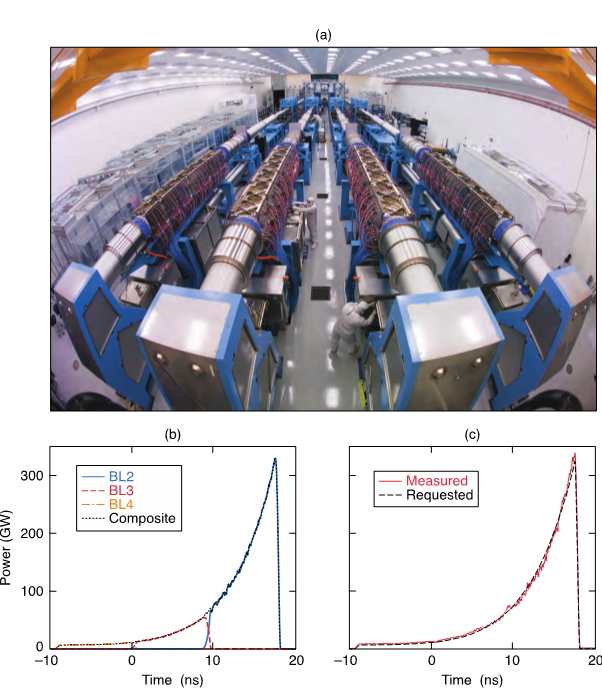M. J. Guardalben
The ability of high-energy laser systems to provide complex laser pulse shapes has growing importance in many research disciplines such as laser fusion, high-energy-density physics, laboratory astrophysics, and laser conditioning of optical materials. In such laser facilities, accurate real-time predictions of laser performance are critical for maximizing experimental and operational effectiveness and flexibility. This is particularly important when real-time guidance is required by the laser facility to satisfy the demands of rapidly evolving experimental campaign needs. For example, x-ray diffraction of ramp-compressed crystalline solids can probe high-pressure solid–solid phase transformations that are inaccessible with shock compression. In this case, the laser pulse shape must be tailored to provide a specific pressure-loading profile that prevents the melting of the material due to an increase in entropy and temperature. Additionally, different ramped pulse shapes may be requested during an experimental campaign when exploring the location of phase boundaries within a complex phase diagram. To provide such laser pulse-shape flexibility over a wide range of energies requires a stable, well-characterized laser system, and an agile laser prediction model that can be optimized in real time to compensate for any drifts that may occur in laser system performance.
Researchers at the University of Rochester's Laboratory for Laser Energetics (LLE) describe an agile laser-system prediction model developed for the OMEGA EP Laser System that has enabled rapid and flexible laser pulse shaping, published in High Power Laser Science and Engineering, Vol. 8, Issue 1, 2020 (M. J. Guardalben, M. Barczys, B. E. Kruschwitz, M. Spilatro, L. J. Waxer, E. M. Hill. Laser-system model for enhanced operational performance and flexibility on OMEGA EP[J]. High Power Laser Science and Engineering, 2020, 8(1): 010000e8).
Essential features of the model are (1) accurate, real-time predictions of expected performance of all four OMEGA EP beamlines within a small fraction of the OMEGA EP shot cycle; (2) an intuitive, easy-to-use interface for laser operators; (3) rapid optimization capability of the code between laser shots to fine-tune predictions based on shot performance; and (4) forward and backward prediction capabilities. These features allow laser-system operators to quickly and accurately optimize laser pulse shape, energy, and laser diagnostic filtrations prior to each OMEGA EP shot. The unique features of the model have also provided greater performance accuracy and flexibility by enabling rapid optimization in the following key areas:
Determination of laser front-end throttle and pulse-shape adjustments required to compensate for such issues as changes in passive loss through a beamline, loss of gain from amplifier flash-lamp degradation, spatial variations in saturated gain resulting from changes in injected beam profile, and spatiotemporal variations in front-end laser performance. This has improved OMEGA EP's ability to accurately produce users' requested laser energies and pulse shapes.
Adjustments to on-target energy and pulse shape within predetermined allowances based on a user's real-time analysis of experimental data.
Increased effective pulse-duration range through precise concatenation of pulses across multiple beams.
Improved system alignment. As a post-shot analysis and diagnostic tool, the laser performance model has been used to guide alignment of beam-shaping apodizers in the front end of OMEGA EP and to understand the effects of beamline-centering errors in order to optimize the fill factor of the amplified beam, reduce near-field modulation, and help elucidate causes of beamline gain changes.
The model's ability to fine-tune complex laser pulse shapes in real time has benefitted several user experiments on OMEGA EP, such as experiments to investigate the transition of alkali metals from conducting, metal-like behavior to nonconducting, insulating behavior at high pressure; experiments to investigate the dominant mechanism in laser–plasma instabilities at intermediate regimes of electron temperature and density scale length; and experiments that probe the crystalline structure and solid-to-liquid ratio of diamond along different temperature/pressure pathways. Future research that will benefit from OMEGA EP's pulse-shaping capability include experiments to tune the energy density of matter into a high-energy-density quantum regime to understand extremes of quantum matter behavior, properties, and phenomena. These compression experiments will tune the distance between atoms, thereby unlocking a new quantum behavior at unprecedentedly high temperatures, transferring quantum phenomena to the macroscale, and opening the potential for hot superconductors, superconducting-superfluid plasma, transparent aluminum, insulating plasma, and potentially more.
"The improved OMEGA EP pulse shaping capabilities now allow us to more accurately probe new states of matter at more extreme conditions than before. This opens fantastic new opportunities for research in Inertial Confinement Fusion (ICF), fundamental condensed matter, planetary sciences and astronomy with capabilities that are very complementary to the National Ignition Facility", stated Dr. Marius Millot, Research Scientist at the Lawrence Livermore National Laboratory, and one of the many users of the OMEGA EP Laser System.
A recent upgrade to the model accounts for the spectral dependence of beamline gain for shots that require spectrally tunable ultraviolet on-target irradiation to mitigate cross-beam energy transfer that reduces the on-target irradiation uniformity required for spherically symmetric implosion of laser-fusion targets. This will be refined to account for the spectral dependence of effective emission cross section and saturation fluence. Due to the success of the model on the OMEGA EP Laser System, a modified version is being adapted for use on LLE's 60-beam OMEGA Laser System.

(a) The OMEGA EP Laser System showing the booster amplifiers in the foreground and target chamber in the distance. (b) Pre-shot prediction and (c) measurement of 27-ns composite ultra-violet pulse formed by incoherent addition of individual beamline pulses. The cover photo was taken from the target chamber area and shows the main-cavity amplifiers firing during a four-beam target shot. (photo credits: Eugene Kowaluk)


